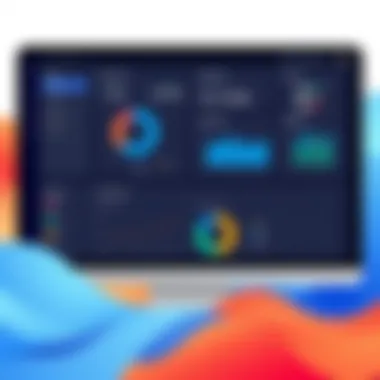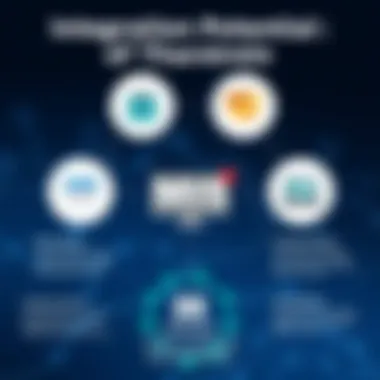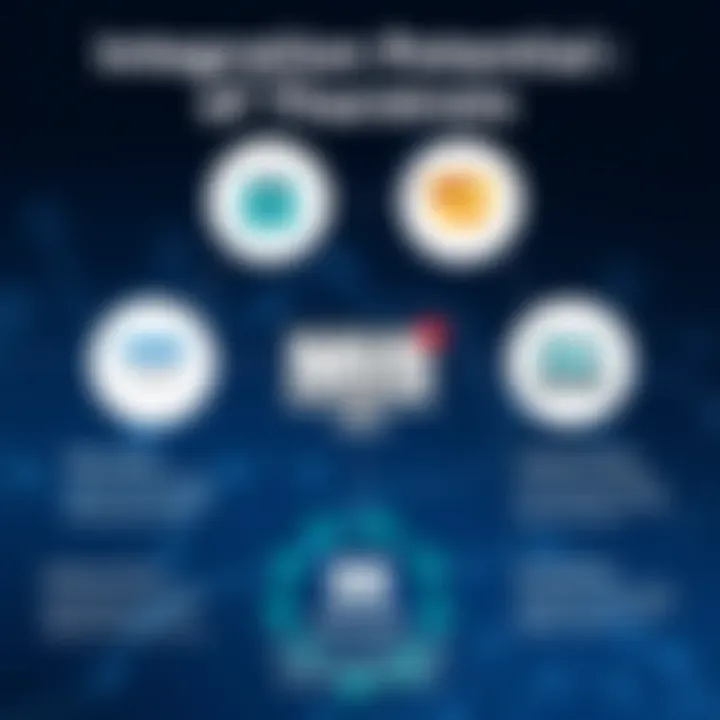Understanding Tharstern MIS: A Guide for Print Professionals


Intro
In the bustling digital age, selecting the right software solution has become akin to finding a needle in a haystack. With countless options at our fingertips, making an informed decision is a critical pursuit, especially in the complex realm of print management. Here, we shine a spotlight on Tharstern MIS, a highly specialized management information system designed specifically for the print industry. Within this article, we will dissect its functionalities, explore its seamless integration potential, and gauge its contributions to operational efficiency. Such insights are paramount for tech-savvy individuals as they navigate their software selection process.
Software Category Overview
Purpose and Importance
Tharstern MIS belongs to a niche category of software tailored to meet the unique demands of printing businesses. As operations become increasingly data-driven, the need for specialized systems that facilitate workflow management, scheduling, and accounting grows ever more vital. The purpose of Tharstern is to synthesize operational processes, allowing companies to track jobs from inception to completion while enabling quick data analysis and reporting.
The importance of such a system cannot be overstated. In an industry where timing and accuracy dictate profitability, a robust management information system is not just a luxury; it’s a necessity. Tharstern helps organizations reduce waste, manage costs effectively, and optimize their production processes.
Current Trends in the Software Category
Looking at the landscape, it's apparent that various trends are shaping the direction of management information systems in the print industry:
- Cloud Integration: Increasingly, companies are gravitating towards cloud-based solutions which allow for flexibility and real-time collaboration.
- Automation and AI: The incorporation of automated workflows and artificial intelligence is enhancing operational efficiency, reducing manual errors.
- User Experience Focus: There’s a growing emphasis on user-friendly interfaces ensuring that all team members, regardless of technical skills, can navigate the system effectively.
These trends signify that industry needs are continuously evolving. Organizations must stay abreast of these developments to remain competitive.
Data-Driven Analysis
Metrics and Criteria for Evaluation
When evaluating Tharstern MIS in relation to other software solutions, certain metrics and criteria play a pivotal role:
- Ease of Integration: How well the system meshes with existing workflows and tools.
- Scalability: The ability of the software to grow with the organization’s needs.
- Cost Efficiency: Overall impact on the budget when operational costs are considered.
Performance on these factors can vary significantly between different software solutions.
Comparative Data on Leading Software Solutions
In analyzing Tharstern MIS alongside its competitors in the print management domain, we observe notable differences:
- Tharstern vs. EFI Pace: While both systems excel in workflow management, Tharstern offers tailored reporting features that cater specifically to print businesses.
- Tharstern vs. Printavo: Printavo focuses more on simplicity and ease of use, yet it lacks the comprehensive accounting features provided by Tharstern that are essential for larger operations.
- Tharstern vs. Reaching New Heights: Although Reaching New Heights touts advanced data analytics, it can fall short in day-to-day operational functionality that Tharstern provides.
In drawing conclusions from these comparisons, potential users can appreciate the nuances that differentiate Tharstern MIS as a compelling option within the software landscape.
Finale
In summary, Tharstern MIS stands as a testament to the necessity of specialized management information systems in the print industry. Its functionalities, coupled with the changing trends and metrics that define software evaluation, embed it firmly as a key player in enhancing productivity for printing businesses. As we delve deeper into subsequent sections, we aim to provide our readers with even more actionable insights that parse through the complexities of software selection.
Preamble to Tharstern MIS
In today's fast-paced world, where technology and efficiency go hand in hand, understanding Tharstern MIS holds significant value for professionals in the print industry. This management information system is not just a tool; it's a game changer that can steer companies toward operational excellence. The importance of Tharstern MIS lies in its ability to streamline processes, improve data accuracy, and ultimately, enhance productivity. In an industry characterized by constant shifts and the need for spontaneous decision-making, having such a system is almost like having a compass in a storm—guiding organizations amidst a sea of operational chaos.
When businesses develop a grasp of Tharstern MIS, they unlock a suite of features designed specifically for their unique needs, which leads to noteworthy improvements. Notably, this system transcends traditional management tools. It integrates various functions—from job management to analytics—into a cohesive platform. This convergence means that users can access all necessary information in one place, making workflows smoother and faster.
Moreover, deploying Tharstern MIS can pave the way for actionable insights derived from comprehensive data analysis. In a sector that highly depends on effective resource allocation and time management, precise data can often make or break profits. With its focus on enhancing decision-making processes, Tharstern MIS allows users to execute data-driven strategies that can lead to significant long-term benefits, thus nurturing a competitive edge.
As we delve into the fundamentals of Tharstern MIS, we will explore its core definition and purpose and trace the evolution of management information systems within the print industry. This exploration will provide professionals with a well-rounded understanding of how MIS has tailored itself to meet specific demands of the market, alongside identifying the benefits that come with implementing such systems.
Definition and Purpose
At its simplest, Tharstern MIS refers to a management information system developed explicitly for the print sector with the primary aim of enhancing operational efficiency. Its purpose extends beyond mere data collection; it is designed to analyze, process, and present information in a manner that aids decision-makers in executing strategies effectively. Users benefit from features like real-time job tracking, resource management, and tailored reporting functionalities that draw insights from raw data.
In essence, a standard management information system can be compared to a map that provides directions. When applying it to the print industry, Tharstern MIS serves as a specialized GPS, guiding organizations through the intricacies of their operations while taking unique challenges into account. Its existence underscores a pivotal shift from reactive to proactive management, allowing companies to not only respond to changes but to anticipate them.
The Evolution of MIS in the Print Industry
The landscape of Management Information Systems, especially in the print industry, has dramatically evolved over time. Initially, many print companies relied on manual processes or basic software to manage their workloads. As the industry grew more complex, the limitations of these early systems became glaringly obvious. Errors in data entry, inefficient job tracking, and a lack of integrated reporting were just a few issues that hampered productivity and led to wastage.
In response to these challenges, Tharstern and others like it embraced technological advancements. Over the years, integrations with cloud computing, automation, and mobile accessibility matured the landscape of MIS solutions. Each evolution marked a significant step in how print companies utilized data; businesses began to realize that they could harness information not just for day-to-day operations, but to shape long-term strategies.
Today, Tharstern MIS stands at the forefront of this evolution. Its capabilities have expanded to include real-time analytics and customizable reports tailored to specific business needs, enabling quicker decisions. In a nutshell, the evolution of MIS in this sector illustrates a trajectory from rudimentary data handling to sophisticated platforms that empower print businesses through better trackability and operational insights, thus revolutionizing how print houses think about their work.


"In the world of print, knowledge is power, and Tharstern MIS acts as the engine driving that power forward."
Through combining cutting-edge technology with industry-specific functions, Tharstern MIS ensures that print organizations are equipped not just to survive but to thrive in a competitive marketplace. Understanding these historical shifts is crucial for professionals looking to implement intelligent solutions and make informed choices about the software they choose.
Core Features of Tharstern MIS
The Tharstern Management Information System (MIS) stands out in the print industry not only for its tailored functionalities but also for its strategic importance in navigating a competitive landscape. The core features of this system address specific challenges faced by print businesses while optimizing operational processes. By anchoring on features like job management, estimating and quoting, production planning, and reporting and analytics, Tharstern MIS enables businesses to streamline their operations and enhance productivity.
Job Management
Job management is fundamental to the Tharstern MIS, central to ensuring that projects run smoothly from inception to completion. The system allows users to oversee all job-related activities in one consolidated interface. This includes real-time updates on job statuses, which ensures that every stakeholder is aligned—be it the sales team, production staff, or management.
Moreover, the efficiency of job management helps identify bottlenecks early in the process. When a hurdle appears, teams can pivot quickly to address the issue before it affects deadlines. This agility is essential in an industry where time is often money. One notable feature is the ability to automate task assignments within teams, ensuring that work is evenly distributed and deadlines are met with reduced stress.
Estimating and Quoting
Estimating and quoting functionalities within Tharstern MIS significantly enhance the accuracy of bids and the speed of response to customer inquiries. Instead of manually calculating costs, which can lead to errors and inconsistencies, the system leverages historical data to provide accurate forecasts.
Users can benefit from features such as customizable templates that reflect current pricing strategies. Clients appreciate quick quotes, so the immediate access to data facilitates timely responses, which can give businesses a competitive edge in a crowded marketplace. Moreover, the integration of estimating tools with live job data means that quotes can be tailored dynamically, reflecting any changes in material costs or production capabilities.
Production Planning
Tharstern MIS excels in production planning by providing tools that align production schedules with available resources, allowing companies to maximize their output effectively. This feature allows businesses to visualize capacity and workload, ensuring that production aligns closely with customer demand.
For example, with drag-and-drop functionality in the scheduling module, planners can easily adjust tasks based on changing priorities. This flexibility is crucial in a field where client requirements can shift at a moment's notice. Furthermore, the forecasting tools help anticipate future demand, enabling companies to make informed staffing and equipment decisions ahead of time, ultimately leading to improved resource management.
Reporting and Analytics
Data-driven decision making is at the heart of effectively managing a print business, and the reporting and analytics features of Tharstern MIS bring this to the forefront. By harnessing the power of data, businesses can track key performance indicators (KPIs) to evaluate the effectiveness of their strategies.
These comprehensive reports can spotlight trends in sales, product performance, and operational efficiency. With this information, businesses are better positioned to make strategic decisions that can lead to cost savings and increased profitability. With user-friendly dashboards, even those less versed in data analytics can glean actionable insights, enabling a full-team approach to data utilization.
The ability to transform raw data into compelling insights is a game changer, particularly in rapidly evolving markets like print, where adaptability is essential.
In wrapping up, the core features of Tharstern MIS aren’t just tools; they are components that, when integrated effectively, foster a culture of efficiency and responsiveness within print businesses. Understanding and utilizing these features can elevate a company to new levels of productivity, setting it on a path that not only meets but exceeds client expectations.
Benefits of Implementing Tharstern MIS
Implementing Tharstern MIS comes with a whole slew of advantages that can significantly enhance business operations within the print sector. It’s not just about adding a software solution to your toolkit; the impact stretches across efficiency, collaboration, and cost management. These benefits create an interconnected web, ensuring that businesses not only work better individually but also as cohesive units.
Increased Efficiency
One of the standout features of Tharstern MIS is its remarkable potential for increasing efficiency. This system streamlines numerous processes that would otherwise demand much more time and manpower. When orders come in, the management information system automates task assignments, monitors project progress, and can even optimize resource allocation.
By reducing manual intervention, companies can focus on their core competencies instead of drowning in paperwork. Moreover, real-time tracking means that decision-makers have immediate access to critical data.
For example, rather than waiting until the end of the month to gauge productivity, staff can assess the current progress on jobs within hours. This level of transparency is crucial in maintaining a nimble operation.
Utilizing features like job scheduling can significantly minimize downtime—avoiding bottlenecks and ensuring smooth workflow from the get-go. When everyone knows what their role is and when it should be executed, the collective effort translates into quicker turnarounds and happier customers.
Enhanced Collaboration
Collaboration is another pivotal benefit that Tharstern MIS brings to the table. In an industry where teams need to seamlessly communicate, the software acts as a centralized hub for information. Everyone—from the sales team to production staff—can access the same data.
This centralization breaks down silos. An estimator can view current production schedules while the production team is updated on changes in job specifications. When everyone is on the same page, errors reduce drastically, and tasks get done in a cordial manner. Additionally, thanks to robust communication channels within the software itself, teams can promptly discuss any work-related issues without reverting to email or other tools. This fluidity reduces delays and enhances camaraderie among team members.
A striking case might involve a client needing urgent changes to their job. Instead of juggling between calls and emails, a simple comment in the Tharstern system facilitates quick communication, allowing all stakeholders to respond rapidly and decisively. This integrated approach can improve staff morale as teams feel empowered to contribute effectively.
Cost Management
The implementation of Tharstern MIS serves as a formidable ally in managing costs more effectively. Few business owners realize how incremental inefficiencies can pile up to create significant financial burdens over time. Tharstern enables organizations to gain insight into their operational costs through its analytics features.
By understanding where money is allocated and identifying wasteful expenditures, businesses can tighten their belts in specific areas. For instance, it provides detailed reports on resource utilization and project profitability, laying bare the costs that might have previously gone unnoticed.
Additionally, the ability to generate precise quotes, based on up-to-date data, ensures that pricing strategies align well with operational costs. This not only helps in pricing jobs more accurately but also improves cash flow management over time.


In short, controlling costs isn't just an invoice matter; it's an ongoing process wherein effective decision-making hinges on robust data insights. With Tharstern MIS, organizations can therefore garner the kind of financial clarity that leads to informed choices, crucial for sustainable growth.
"Investing in Tharstern MIS is akin to getting a crystal ball that reveals the true state of your operations—through this lens, businesses can navigate toward profitability without stumbling in blind spots."
In summary, the adoption of Tharstern MIS stands as a transformative decision that can optimize operations, foster effective collaboration, and enhance cost management. Each element intertwined into its functionality means that businesses can prepare to tackle industry challenges head on.
Relevant Links:
- Tharstern's Official Website
- Understanding Management Information Systems
- Industry Insights on Print Management
- User Experiences on Reddit
Integration Capabilities
In today’s fast-paced digital landscape, the ability to integrate different software solutions smoothly is no longer a luxury, but a necessity. For organizations in the print industry, especially those utilizing Tharstern MIS, having robust integration capabilities can be a game changer. This allows businesses to connect various tools and systems, streamlining their operations and enhancing overall productivity. When you think about it, the print industry is a complex web of processes, from order management to production scheduling. Without effective integration, organizations risk working in silos, where information gaps can lead to inefficiencies and lost revenue.
Integration capabilities facilitate data flow across systems, ensuring that every department – from sales to production to finance – works with the same up-to-date information. This not only enhances collaboration but also minimizes the chances of errors that can occur when data is manually entered into multiple systems. In this section, we’ll delve deeper into two key aspects: compatible software solutions and APIs and custom integrations.
Compatible Software Solutions
When considering Tharstern MIS, one of the standout features is its compatibility with various software solutions. Many systems lack the flexibility to incorporate different tools; however, Tharstern addresses this head-on. The compatibility with popular tools such as accounting software like Xero or Sage allows businesses to synchronize financial data seamlessly. This means invoices can be raised without double-entry, freeing up valuable time for finance teams.
Moreover, CRM systems like Salesforce can integrate with Tharstern MIS to improve customer relationship management. The result? A 360-degree view of the customer, which is invaluable for personalized service and timely follow-ups. Here are some benefits associated with these compatible solutions:
- Streamlined Workflow: Reduces manual data entry and associated errors.
- Real-time Data Updates: Keeps all departments informed about current statuses, improving decision-making speed.
- Enhanced Visibility: Offers insights into various business areas, from sales forecasts to production timelines.
Integrating with electronic proofing tools, like Switch, can also streamline the approval process, reducing the back-and-forth that often delays projects. By utilizing compatible software solutions, organizations can position themselves for growth and improved service delivery.
APIs and Custom Integrations
APIs, or Application Programming Interfaces, are the unsung heroes of software integration. They enable different systems to communicate effectively, allowing users to pull or push data as needed. Tharstern's MIS features a flexible API, opening a world of possibilities for customization and integration. This means businesses can tailor the software to meet their specific requirements, rather than adapting their workflows to fit a one-size-fits-all solution.
Custom integrations are particularly useful for companies with unique processes that aren’t well-served by standard options. For instance, a print shop may wish to connect its eCommerce platform directly to Tharstern MIS. Doing so enables automatic order processing and inventory management without manual intervention. Here’s what effective API use can lead to:
- Customization: Tailor processes to niche needs.
- Enhanced Efficiency: Allow data to flow in real-time from one system to another, reducing lag time.
- Scalability: As businesses grow, APIs make it easier to plug in new systems without overhauling existing infrastructure.
This approach brings the potential for innovation. Companies can develop new functionalities or enhancements that align with their business strategy, setting themselves apart in a competitive landscape.
"Tharstern's MIS offers tremendous flexibility through API integrations, enabling businesses in the print sector to not just adapt but thrive in an ever-evolving market."
By understanding and leveraging these integration capabilities, businesses can ensure they're not just keeping pace but leading the way in operational efficiency and productivity.
User Experiences and Case Studies
Understanding how a system functions in real-world applications is essential, especially when dealing with a complex tool like Tharstern MIS. User experiences and case studies not only illuminate the benefits of such software but also expose the practical challenges faced during implementation. By examining actual testimonials and real-world scenarios, potential adopters can gain insight into how Tharstern MIS aligns with their operational needs, paving the way for informed decision-making. Here, we dive into user-driven narratives and concrete examples of Tharstern’s application in the printing industry.
Testimonials from Users
Testimonials from users offer a frontline perspective on how Tharstern MIS enhances workflow and promotes productivity. These narratives often highlight specific outcomes achieved through the implementation of the system.
For instance, a medium-sized print company based in the UK reported a dramatic reduction in turnaround times for client orders. According to their production manager, "Tharstern MIS streamlined our job management processes, cutting down our internal communication lags. This has helped us deliver projects ahead of schedule, increasing customer satisfaction."
Moreover, another user noted the system's role in fostering collaboration within teams. An operations supervisor shared, "With Tharstern, our staff can access real-time job updates and collaborate efficiently—even when working remotely. It has created a more connected workplace, leading to less confusion."
These individual experiences reflect the system's practical advantages and offer credibility to its touted benefits. Transitioning from skepticism to appreciation often hinges on hearing firsthand accounts of success.
Real-World Implementations
Real-world implementations lend further authenticity to these user accounts, exemplifying how Tharstern MIS can be utilized in various capacities within the print industry.
Take, for example, a case involving a large-scale commercial printer that specialized in packaging solutions. Their transition to Tharstern MIS was not without hurdles. Initial user resistance stemmed from unfamiliarity with the new software. However, after comprehensive training and tailored workshops, the workforce became adept at navigating the system. The result? A full 30% increase in overall production efficiency.
In another notable instance, a niche print firm integrated Tharstern MIS with their existing workflow management systems. They employed APIs to customize functionality to their specific needs. This bespoke integration allowed them to automate routine tasks, thereby freeing up valuable time for creative strategizing.
Implementation can vary greatly depending on the organization's size and specific needs, yet the adaptable nature of Tharstern MIS remains a common thread in positive user experiences. Adopting such a solution is not merely about acquiring new software—it is about integrating it into the very fabric of operational processes.
"In the fast-paced print industry, staying ahead of the competition often hinges on leveraging the right tools. Tharstern MIS is one such tool, empowering businesses to sharpen their edge and enhance productivity."


User experiences and case studies are vital components of evaluating any management information system, and Tharstern MIS shines in this regard. Through the lens of its users, we observe an impactful narrative of transformation, efficiency, and innovation that sets the stage for future endeavors within the print sector.
Challenges and Considerations
In the ever-evolving landscape of the print industry, implementing a Management Information System (MIS) like Tharstern brings its own set of hurdles and essential considerations. Addressing these challenges is not only crucial for immediate operational success but also for long-term sustainability and growth. Companies must recognize that the adoption of such sophisticated systems does not come without its pitfalls; being proactive is the key to navigating through potential roadblocks. Understanding this landscape allows organizations to optimize their return on investment, minimize disruption, and lay a foundation for their future needs.
Common Implementation Challenges
Implementing Tharstern MIS is a journey that can often be likened to steering a ship through turbulent waters. There are a few significant challenges that businesses might face:
- Resistance to Change: Employees accustomed to legacy systems may resist the transition to new software due to fears of the unknown or doubts about the benefits of the new system.
- Data Migration Difficulties: Moving data from outdated systems to Tharstern MIS is often fraught with complications, including data loss, format incompatibility, and potential errors during the transfer process.
- Training Requirements: A well-designed system is only as effective as the people using it. Frequently, organizations neglect the importance of comprehensive training, which can lead to underutilization of the MIS capabilities.
- Customization Overload: Tailoring the system to fit specific operational needs can be a double-edged sword. While customization enhances usability, it can also create complexities during implementation and ongoing maintenance.
These challenges highlight a vital aspect of the software adoption process. Something as straightforward as aligning software features with user expectations is not as simple as it seems.
Mitigation Strategies
Overcoming these obstacles requires strategic thinking and a structured approach. Here are some effective strategies to consider:
- Cultivate a Change Management Culture: Foster an environment where employees feel supported during the transition. Involve them early in the process, gather feedback, and reinforce the benefits of Tharstern MIS.
- Establish a Robust Data Migration Plan: Prioritize a thorough assessment of existing data. Engage IT specialists to ensure smooth migration to prevent data loss or corruption, thus safeguarding valuable insights.
- Invest in Comprehensive Training Programs: Tailor training sessions to different user roles, ensuring that everyone is equipped to navigate the system effectively. Consider follow-up sessions to address ongoing questions or issues.
- Limit Customization to Core Needs: While the allure of customizing every single feature is tempting, focus on modifications that genuinely enhance efficiency and usability. This approach prevents unnecessary complexity and ensures smoother maintenance.
"The more you can anticipate and prepare for these challenges, the smoother your journey will be when implementing Tharstern MIS."
By identifying potential pain points early and employing thoughtful mitigation strategies, organizations can significantly improve their chances of a successful implementation. This proactive mindset ultimately sets the stage for leveraging Tharstern MIS as a powerful tool in the print industry.
The Future of Tharstern MIS
The landscape of management information systems is constantly shifting, much like the tides in the ocean. Tharstern MIS stands at the intersection of technology and the print industry, where the need for adaptability is vital. Looking ahead, it's crucial to consider evolving trends and technologies that will shape this system and its integration processes.
Understanding the trajectory of Tharstern MIS is more than just a passing interest; it’s about grasping how this system can continue to provide value in a highly competitive market. As businesses undergo digital transformation, Tharstern must stay relevant and responsive to emerging needs and challenges in the print sector.
Emerging Trends in MIS Technology
As the world grapples with rapid technological advancements, several key trends are worth monitoring within the MIS landscape that could significantly influence Tharstern's future development. Some noteworthy trends include:
- Cloud Computing: As businesses pivot towards remote work, adopting cloud-based solutions is no longer just a luxury but a necessity. Tharstern MIS could leverage this by offering enhanced access to data and processes from virtually anywhere, fostering seamless collaboration and improving data security.
- Artificial Intelligence: Machine learning algorithms can analyze vast amounts of data more efficiently and accurately than any human. Tharstern might incorporate AI-driven analytics to help businesses predict trends, optimize operations, and make data-informed decisions.
- Automation: The push towards automation continues to grow. Businesses are eager to free up employee time from mundane tasks. Tharstern can benefit from integrating robotic process automation, making everyday operations slicker and quicker.
- User-Centric Design: As the end-user experience becomes paramount, MIS will need to offer intuitive interfaces that enhance usability. Tharstern should prioritize user feedback to refine its system interface, ensuring it meets the practical needs of its users.
"Embracing emerging trends in technology is not an option for Tharstern MIS; it's a survival strategy."
Predictions for Ongoing Development
The future of Tharstern MIS is not set in stone; it’s a narrative that is still being written. Here, we can project several possibilities based on current trends and user feedback:
- Greater Integration Capabilities: As both users and companies expand their software choices, the need for Tharstern to refine its integration capabilities will be paramount. Anticipating seamless interaction with third-party applications can enhance its overall functionality.
- Enhanced Data Security Measures: With increasing data breaches across industries, security is an ever-growing concern. Future iterations of Tharstern MIS will likely focus on tightening data protection features, integrating advanced encryption and user authentication protocols.
- Sustainability Initiatives: As the world gears toward sustainability, Tharstern MIS might increasingly incorporate tools that assist companies in tracking their environmental impact, contributing positively to the print industry's shift toward greener practices.
- Real-Time Insights: The demand for immediate access to information is ushering in a new era where real-time analytics might become standard features of Tharstern MIS. This could arm businesses with actionable insights for rapid decision-making and trend responses.
- Continuous Feedback Loops: The idea is that user experience will drive ongoing system development. Tharstern will likely implement regular updates that incorporate user suggestions, creating a dynamic where the system evolves alongside its users' needs.
As we navigate toward a future filled with possibilities, it’s evident that Tharstern MIS is poised for significant transformations, all aimed at optimizing processes, enhancing productivity, and ensuring that users are not just keeping up, but thriving in their business environments.
End
As we wrap up our exploration of Tharstern MIS, the focus here is on understanding why the conclusion of this article holds profound significance. In a world where the print industry faces constant change, grasping the comprehensive insights learned is vital for professionals eager to enhance their operations.
Summarizing Key Insights
Over the course of this article, we've dissected the foundational aspects of Tharstern MIS, touching upon its core features and functionalities. Here are some key takeaways:
- Job Management and Workflow: Tharstern streamlines job processes, allowing teams to manage tasks efficiently, reducing delays and enhancing productivity.
- Estimated Accuracy: Accurate estimating and quoting help businesses remain competitive in pricing supplies and services.
- Integrated Analytics: Reporting tools provide clarity regarding operations, enabling data-driven decisions that could influence future strategies.
Understanding these insights not only provides clarity on what Tharstern MIS offers but also illuminates how these functionalities mesh with the needs of the print sector.
Making an Informed Decision
The final step in our discussion hinges on the importance of making informed decisions when adopting management systems like Tharstern MIS. Deciding what software to implement should not be taken lightly, as it's a major investment of resources. Here are several considerations:
- Assessing Compatibility: Consider what existing software solutions you have and how well they integrate with Tharstern. Compatibility can save time and reduce costs during implementation.
- User Experience: Prioritize the feedback from existing users. Testimonials can provide insights into real-world performance and usability.
- Scalability: Ensure that the chosen system can grow alongside your business needs. A system that meets current demands while having the potential for future scalability can make a world of difference.
Ultimately, aligning the capabilities of Tharstern with your specific operational goals can lead to not just improvements in efficiency, but also in overall business efficacy. By articulating these points clearly, we aim to empower you, the reader, to proceed confidently in the complex landscape of software selection.
"Informed decisions require understanding the lay of the land, and Tharstern MIS offers a clear pathway in the print industry."
For further reading on software selection for businesses, consider exploring resources available at Harvard Business Review or Gartner.
By analyzing industry trends and user experiences, we highlighted how crucial it is to reflect carefully before taking the plunge into the world of management information systems.







